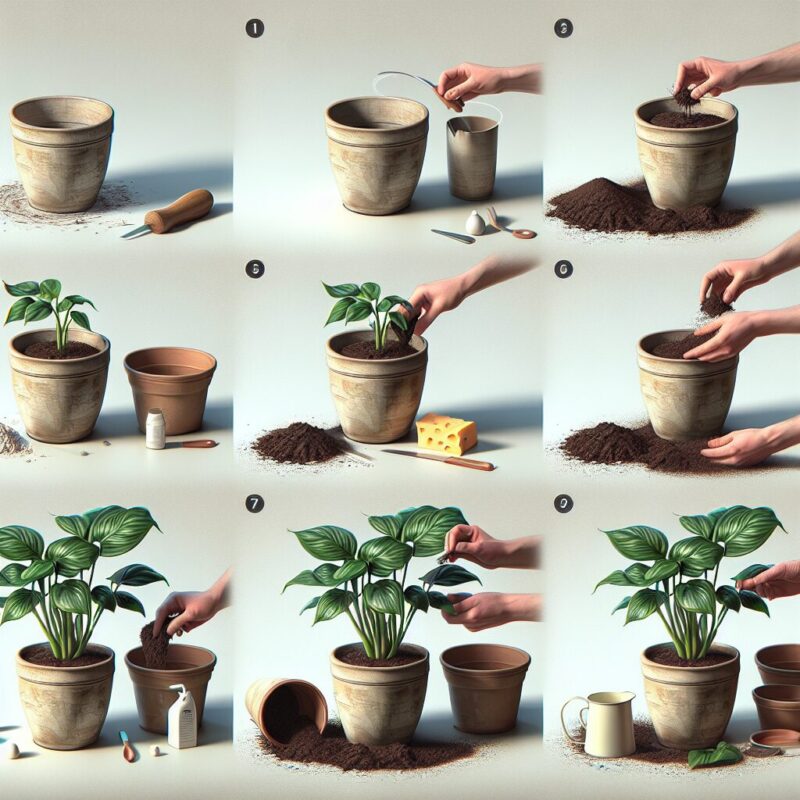Why Repot Your Swiss Cheese Plant?
Repotting a Swiss Cheese Plant is an essential part of its care and maintenance. As the plant grows, it will eventually outgrow its container and require fresh soil and a larger pot to continue thriving. Repotting also provides an opportunity to train the plant to climb up a moss pole, which can help to promote healthy growth and encourage the plant to produce more leaves. By repotting your Swiss Cheese Plant with a moss pole, you can give it the support it needs to reach its full potential and create a stunning display in your home.
One of the main benefits of repotting a Swiss Cheese Plant is the chance to refresh the soil. Over time, the soil in the pot can become depleted of nutrients, which can impact the plant’s ability to grow and thrive. By repotting the plant in fresh soil, you can provide it with the nutrients it needs to continue growing and producing new leaves. Additionally, repotting allows you to inspect the plant’s roots and prune them if necessary, which can help to prevent the plant from becoming pot-bound.
Another advantage of repotting a Swiss Cheese Plant with a moss pole is the ability to train the plant to climb. Swiss Cheese Plants are natural climbers, and by providing them with a moss pole, you can encourage them to grow upwards and create a stunning display. This can also help to promote healthy growth and encourage the plant to produce more leaves. By training the plant to climb, you can create a beautiful and unique display that will add a touch of elegance to any room.
Overall, repotting a Swiss Cheese Plant with a moss pole is a great way to give your plant the support it needs to thrive. By providing fresh soil, a larger pot, and a moss pole, you can create an environment that will allow your plant to reach its full potential and create a stunning display in your home. Whether you’re a seasoned plant enthusiast or just starting out, repotting your Swiss Cheese Plant with a moss pole is a great way to take your plant care to the next level.
Choosing the Right Time to Repot
When it comes to repotting a Swiss Cheese Plant, timing is everything. Repotting at the right time can make all the difference in the plant’s ability to thrive and adapt to its new environment. So, when is the best time to repot a Swiss Cheese Plant?
The optimal time to repot a Swiss Cheese Plant is during the spring and summer months when the plant is actively growing. This allows the plant to quickly establish itself in its new pot and take advantage of the fresh soil and nutrients. Avoid repotting during the fall and winter months when the plant is dormant, as this can cause unnecessary stress and potentially lead to disease or pest issues.
In addition to the time of year, it’s also important to consider the plant’s growth cycle. Swiss Cheese Plants typically need to be repotted every 1-2 years as they outgrow their containers. If you notice that your plant is becoming pot-bound, with roots growing out of the drainage holes or circling around the inside of the pot, it’s likely time to repot.
Other signs that your Swiss Cheese Plant needs to be repotted include yellowing or droopy leaves, slow growth, or a decrease in leaf production. If you notice any of these signs, it’s likely that the plant is in need of fresh soil and a larger pot.
When repotting a Swiss Cheese Plant with a moss pole, it’s also important to consider the plant’s moisture levels. Make sure the plant is not too dry or too wet, as this can cause stress and make the repotting process more difficult. By choosing the right time to repot and taking the necessary precautions, you can give your Swiss Cheese Plant the best chance to thrive and continue to grow.
Preparing Your Swiss Cheese Plant for Repotting
Before repotting your Swiss Cheese Plant with a moss pole, it’s essential to prepare the plant properly. This will help minimize stress and ensure a smooth transition to the new pot. Here are some tips to help you prepare your plant:
Pruning is an essential step in preparing your Swiss Cheese Plant for repotting. Remove any dead or damaged leaves, as these can be a sign of disease or pests. Cut back any leggy stems to encourage bushy growth and promote a fuller plant. Use clean, sharp pruning tools to prevent spreading disease.
Watering is also crucial before repotting. Make sure the soil is moist but not waterlogged, as this can cause the roots to rot. Check the soil moisture by sticking your finger into the soil up to the first knuckle. If the soil feels dry, it’s time to water.
Fertilizing is another important step in preparing your Swiss Cheese Plant for repotting. Feed your plant with a balanced, water-soluble fertilizer to provide essential nutrients for healthy growth. Dilute the fertilizer to half the recommended strength to avoid burning the roots.
In addition to pruning, watering, and fertilizing, it’s also essential to inspect the plant’s roots. Gently remove the plant from its pot and inspect the roots for any signs of damage or disease. Trim any damaged roots with clean, sharp pruning tools to prevent the spread of disease.
By following these simple steps, you can help prepare your Swiss Cheese Plant for repotting with a moss pole. This will give your plant the best chance to thrive in its new environment and continue to grow and flourish.
Remember to handle the plant gently and avoid over-handling the roots, as this can cause stress and lead to disease or pest issues. With proper preparation and care, your Swiss Cheese Plant will be ready to thrive in its new pot with a moss pole.
Selecting the Perfect Moss Pole
When it comes to repotting a Swiss Cheese Plant with a moss pole, selecting the right moss pole is crucial. A moss pole provides support for the plant to climb, helping to promote healthy growth and encourage the plant to produce more leaves. But with so many types of moss poles available, how do you choose the right one for your Swiss Cheese Plant?
There are several types of moss poles available, including wooden, bamboo, and plastic. Wooden moss poles are a popular choice, as they are durable and can be easily attached to the pot. Bamboo moss poles are also a good option, as they are lightweight and can be easily trimmed to size. Plastic moss poles are another option, but they may not be as durable as wooden or bamboo poles.
When selecting a moss pole, consider the size of your Swiss Cheese Plant. A larger plant will require a taller moss pole, while a smaller plant can use a shorter pole. Also, consider the material of the moss pole and whether it will complement the pot and the plant’s foliage.
Another important factor to consider is the texture of the moss pole. A moss pole with a rough texture can provide better support for the plant’s stems, while a smooth texture may not provide enough grip. Look for a moss pole with a texture that will provide the right amount of support for your Swiss Cheese Plant.
Finally, consider the price of the moss pole. Moss poles can range in price from a few dollars to over $20, depending on the material and size. Set a budget and look for a moss pole that fits within it.
By considering these factors, you can select the perfect moss pole for your Swiss Cheese Plant. With the right moss pole, you can provide your plant with the support it needs to thrive and continue to grow.
A Step-by-Step Guide to Repotting with a Moss Pole
Repotting a Swiss Cheese Plant with a moss pole can seem intimidating, but with the right steps, you can give your plant the support it needs to thrive. Here’s a step-by-step guide on how to repot your Swiss Cheese Plant with a moss pole:
Step 1: Prepare the Pot and Moss Pole
Before starting the repotting process, make sure you have a pot that is slightly larger than the previous one and a moss pole that is the right size for your plant. If you’re using a wooden or bamboo moss pole, make sure it’s clean and dry before use.
Step 2: Remove the Plant from the Old Pot
Carefully remove the Swiss Cheese Plant from its old pot, taking care not to damage the roots or disturb the soil. If the plant is stuck, gently rock it back and forth to loosen it.
Step 3: Inspect and Trim the Roots
Inspect the roots of the plant and trim any dead or damaged roots with a pair of clean scissors or pruning shears. This will help prevent the spread of disease and encourage healthy growth.
Step 4: Plant the Moss Pole
Plant the moss pole in the new pot, making sure it’s centered and secure. If using a wooden or bamboo moss pole, you can attach it to the pot using a small amount of soil or a moss pole clip.
Step 5: Add Fresh Soil and Plant the Swiss Cheese Plant
Add fresh soil to the pot, leaving enough space for the Swiss Cheese Plant’s roots to grow. Plant the Swiss Cheese Plant in the pot, making sure the soil level is the same as it was in the old pot.
Step 6: Secure the Plant to the Moss Pole
Use a soft material like twine or a plant tie to secure the Swiss Cheese Plant to the moss pole. Make sure the tie is not too tight, as this can damage the plant’s stems.
By following these steps, you can successfully repot your Swiss Cheese Plant with a moss pole and give it the support it needs to thrive.
Training Your Swiss Cheese Plant to Climb
Once you’ve repotted your Swiss Cheese Plant with a moss pole, it’s time to train it to climb. Training your plant to climb up the moss pole can be a fun and rewarding experience, and with the right techniques, you can encourage your plant to grow and thrive.
To train your Swiss Cheese Plant to climb, start by gently twining the stems around the moss pole. Use a soft material like twine or a plant tie to secure the stems to the pole, making sure not to tie them too tightly. As the plant grows, you can adjust the ties to keep the stems secure.
Pruning is also an important part of training your Swiss Cheese Plant to climb. Prune any stems that are growing away from the moss pole, and trim back any stems that are getting too long. This will help encourage the plant to grow upwards and outwards, rather than sprawling outwards.
Providing support is also crucial when training your Swiss Cheese Plant to climb. Make sure the moss pole is sturdy and secure, and provide additional support if necessary. You can use stakes or trellises to provide extra support, or even attach the moss pole to a wall or other stable surface.
As your Swiss Cheese Plant grows and climbs up the moss pole, make sure to provide it with plenty of light and water. Keep the soil consistently moist, but not waterlogged, and provide bright, indirect light. With the right care and attention, your plant should thrive and continue to grow.
Remember to be patient when training your Swiss Cheese Plant to climb. It may take some time for the plant to adjust to its new surroundings and start climbing up the moss pole. But with the right techniques and care, you can encourage your plant to grow and thrive, and enjoy the beautiful display of foliage and flowers that it provides.
Common Mistakes to Avoid When Repotting with a Moss Pole
Repotting a Swiss Cheese Plant with a moss pole can be a bit tricky, and there are several common mistakes to avoid. By being aware of these mistakes, you can ensure that your plant thrives and continues to grow.
One of the most common mistakes to avoid is over-handling the roots. When repotting, it’s essential to handle the roots gently and avoid damaging them. If the roots are damaged, the plant may become stressed, and its growth may be affected.
Another mistake to avoid is using too much fertilizer. While fertilizer can be beneficial for plant growth, too much of it can cause more harm than good. Make sure to follow the instructions on the fertilizer package and avoid over-fertilizing.
Not providing enough support is another common mistake to avoid. When repotting with a moss pole, make sure to provide enough support for the plant to climb. This can be achieved by using a sturdy moss pole and securing the plant to it with twine or a plant tie.
Not watering correctly is also a common mistake to avoid. When repotting, make sure to water the plant correctly to prevent over-watering or under-watering. Check the soil moisture by sticking your finger into the soil up to the first knuckle, and adjust the watering schedule accordingly.
Finally, not pruning correctly is another mistake to avoid. When repotting, make sure to prune the plant correctly to encourage healthy growth and prevent disease. Prune any dead or damaged leaves, and trim back any stems that are getting too long.
By avoiding these common mistakes, you can ensure that your Swiss Cheese Plant thrives and continues to grow. Remember to always handle the roots gently, use the right amount of fertilizer, provide enough support, water correctly, and prune correctly.
Aftercare and Maintenance
After repotting your Swiss Cheese Plant with a moss pole, it’s essential to provide the right aftercare and maintenance to ensure the plant thrives and continues to grow. Here are some tips to help you care for your plant:
Watering is crucial after repotting. Make sure to water your Swiss Cheese Plant thoroughly, but avoid over-watering. Check the soil moisture by sticking your finger into the soil up to the first knuckle, and adjust the watering schedule accordingly.
Fertilizing is also important after repotting. Use a balanced, water-soluble fertilizer to provide essential nutrients for healthy growth. Dilute the fertilizer to half the recommended strength to avoid burning the roots.
Pruning is another essential part of aftercare and maintenance. Prune any dead or damaged leaves, and trim back any stems that are getting too long. This will help encourage healthy growth and prevent disease.
Providing enough light is also crucial after repotting. Make sure your Swiss Cheese Plant is placed in a spot with bright, indirect light. Avoid direct sunlight, as it can cause the leaves to become scorched.
Humidity is also important for Swiss Cheese Plants. Make sure the air around your plant is humid, but not too humid. You can use a humidifier or group plants together to create a microclimate.
By following these tips, you can ensure your Swiss Cheese Plant thrives and continues to grow after repotting with a moss pole. Remember to be patient, as it may take some time for the plant to adjust to its new surroundings.







